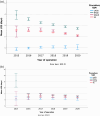The length of hospital stay following bariatric surgery in Australia: the impact of patient, procedure, system and surgeon
- PMID: 37338075
- PMCID: PMC10952963
- DOI: 10.1111/ans.18575
The length of hospital stay following bariatric surgery in Australia: the impact of patient, procedure, system and surgeon
Abstract
Background: The length of a patient's stay (LOS) in a hospital is one metric used to compare the quality of care, as a longer LOS may flag higher complication rates or less efficient processes. A meaningful comparison of LOS can only occur if the expected average length of stay (ALOS) is defined first. This study aimed to define the expected ALOS of primary and conversion bariatric surgery in Australia and to quantify the effect of patient, procedure, system, and surgeon factors on ALOS.
Methods: This was a retrospective observational study of prospectively maintained data from the Bariatric Surgery Registry of 63 604 bariatric procedures performed in Australia. The primary outcome measure was the expected ALOS for primary and conversion bariatric procedures. The secondary outcome measures quantified the change in ALOS for bariatric surgery resulting from patient, procedure, hospital, and surgeon factors.
Results: Uncomplicated primary bariatric surgery had an ALOS (SD) of 2.30 (1.31) days, whereas conversion procedures had an ALOS (SD) of 2.71 (2.75) days yielding a mean difference (SEM) in ALOS of 0.41 (0.05) days, P < 0.001. The occurrence of any defined adverse event extended the ALOS of primary and conversion procedures by 1.14 days (CI 95% 1.04-1.25), P < 0.001 and 2.33 days (CI 95% 1.54-3.11), P < 0.001, respectively. Older age, diabetes, rural home address, surgeon operating volume and hospital case volume increased the ALOS following bariatric surgery.
Conclusions: Our findings have defined Australia's expected ALOS following bariatric surgery. Increased patient age, diabetes, rural living, procedural complications and surgeon and hospital case volume exerted a small but significant increase in ALOS.
Study type: Retrospective observational study of prospectively collected data.
Keywords: bariatric surgery; efficiency; obesity; outcomes; safety.
© 2023 The Authors. ANZ Journal of Surgery published by John Wiley & Sons Australia, Ltd on behalf of Royal Australasian College of Surgeons.
Conflict of interest statement
Chiara Chadwick: This research was supported by an Australian Government Research Training Program (RTP) Scholarship. Paul R. Burton: None declared. Dianne Brown: None declared. Jennifer F. Holland: None declared. Angus Campbell: None declared. Jenifer Cottrell: None declared. Jennifer Reilly: None declared. Andrew D. MacCormick: None declared. Ian Caterson: Grants for clinical trials from Boehringer Ingelheim, Eli Lilly, and Sydney Local Health Districts. Currently, serves on the advisory board of InsideOut (for eating disorders), the board of Obesity Australia, and chairs the Executive Management Committee of the Australian and New Zealand Bariatric Surgical Register. He was past president of the World Obesity Federation. Wendy A. Brown: Grants from Johnson and Johnson, Medtronic, GORE, Applied Medical, and the Australian Commonwealth Government for the ANZ Bariatric Surgery Registry. Additional grant funding from Novo Nordisc, NHMRC, Myerton, Personal fees from GORE, Novo Nordisc, Pfizer and Merck Sharpe and Dohme for lectures and advisory boards.
Figures
Comment in
-
Clinical quality registries: is government listening?ANZ J Surg. 2023 Dec;93(12):2782. doi: 10.1111/ans.18706. ANZ J Surg. 2023. PMID: 38149714 No abstract available.
-
Complexities of bariatric surgery funding and registry capture limits LOS conclusion applicability.ANZ J Surg. 2024 May;94(5):976. doi: 10.1111/ans.18943. Epub 2024 Mar 25. ANZ J Surg. 2024. PMID: 38525856 No abstract available.
Similar articles
-
Patient Characteristics, Procedural and Safety Outcomes of Bariatric Surgery in England: a Retrospective Cohort Study-2006-2012.Obes Surg. 2018 Apr;28(4):1098-1108. doi: 10.1007/s11695-017-2978-x. Obes Surg. 2018. PMID: 29076010 Free PMC article.
-
Length of stay by uncomplicated diabetes bariatric surgery patients: A laparoscopic adjustable banding versus laparoscopic sleeve gastrectomy.J Eval Clin Pract. 2019 Oct;25(5):779-787. doi: 10.1111/jep.13068. Epub 2018 Nov 13. J Eval Clin Pract. 2019. PMID: 30426595
-
Bariatric Surgery in the Elderly Patient: Safety and Short-time Outcome. A Case Match Analysis.Obes Surg. 2019 Mar;29(3):1007-1011. doi: 10.1007/s11695-018-03633-2. Obes Surg. 2019. PMID: 30536201
-
Clinical outcomes and adverse events of bariatric surgery in adults with severe obesity in Scotland: the SCOTS observational cohort study.Health Technol Assess. 2024 Jan;28(7):1-115. doi: 10.3310/UNAW6331. Health Technol Assess. 2024. PMID: 38343107 Free PMC article.
-
Efficiency and Safety Effects of Applying ERAS Protocols to Bariatric Surgery: a Systematic Review with Meta-Analysis and Trial Sequential Analysis of Evidence.Obes Surg. 2017 Feb;27(2):489-501. doi: 10.1007/s11695-016-2442-3. Obes Surg. 2017. PMID: 27878754
Cited by
-
Evaluation of the cost and care outcomes by group related to the diagnosis of bariatric surgery.BMC Surg. 2024 Nov 29;24(1):381. doi: 10.1186/s12893-024-02682-y. BMC Surg. 2024. PMID: 39614214 Free PMC article.
References
-
- Australian Institute of Health and Welfare 2017 . Weight loss surgery in Australia 2014–15: Australian hospital statistics. Cat. no. HSE 186. Canberra: AIHW.
-
- Backman B, Brown D, Cottrell J, et al. The Bariatric Surgery Registry Annual Report, 2015. Monash University, Department of Epidemiology and Preventive Medicine, August. 2015.
-
- Backman B, Brown D, Cottrell J, et al. The Bariatric Surgery Registry Annual Report, 2019. Monash University, Department of Epidemiology and Preventive Medicine, August. 2019.
-
- Metabolic and bariatric surgery fact sheet: ASMBS [American Society for Metabolic and Bariatric Surgery website], August 6. 2021. [Cited 11 Nov 2022.] Available from URL: https://asmbs.org/resources/metabolic-and-bariatric-surgery.
Publication types
MeSH terms
Grants and funding
LinkOut - more resources
Full Text Sources
Medical




